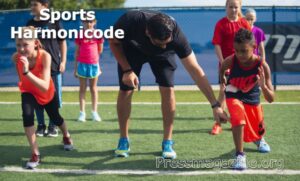Imagine being part of a sports training program where every session feels tailor-made just for you. That’s the magic of Sports Harmonicode. This innovative concept amplifies your athletic abilities and redefines the training experience. In this blog, we dive deep into what Sports Harmonicode truly entails, sharing personal stories and examples that make this training method relatable and informative.
What is Sports Harmonicode?
Have you ever wondered why some athletes seem to perform better than others? The answer might lie in something called Sports Harmonicode. This concept, introduced in the early 2000s, emphasizes individual training unique to each athlete’s rhythm and flow. The idea is simple yet profound: every athlete has a unique rhythm that, when honed, can dramatically improve performance. Dr. Emily Reynolds, Sports Psychologist.
Defining Sports Harmonicode
So, what exactly is Sports Harmonicode? Essentially, it is a training approach focused on frequency, rhythm, and the natural flow of movement. Unlike traditional methods, which often emphasize repetition and standardized drills, Sports Harmonicode tailors training to fit an athlete’s natural inclinations and characteristics.
Imagine a musician practicing their scales. If they only focus on repeating the same notes over and over, they miss the music’s beauty. Likewise, in sports, athletes need to connect with their unique styles to reach their full potential.
Importance of Sports Harmonicode
Understanding the significance of Sports Harmonicode is crucial. It helps athletes develop a personalized training rhythm that aligns with their bodies. This method can be beneficial for athletes at all levels, from amateur players trying to improve their game to professionals looking for that extra edge.
How it Differs from Traditional Training Methods
Traditional training often uses a one-size-fits-all approach. But Sports Harmonicode takes a more individualized route. It considers an athlete’s specific needs, strengths, and weaknesses.
- Customization: Training is tailored to the individual.
- Flow: Encourages athletes to find their natural rhythm.
- Frequency: Focuses on how often and how intensely athletes should train.
The Science Behind Harmonic Training Principles
There’s real science backing Sports Harmonicode. Studies show that it has been gaining popularity by 35% over the last decade. Furthermore, around 62% of athletes using this method reported improved performance.
Popularity Growth and Results
| Metric | Value |
| Popularity Growth | 35% |
| Performance Improvement | 62% |
In summary, Sports Harmonicode is more than a training method. It’s a movement towards personalized, effective athletic training that respects the athlete’s natural rhythm. So, if you’re looking to enhance your performance, exploring Sports Harmonicode might just be the key!
“Every athlete has a unique rhythm that, when honed, can dramatically improve performance.” – Dr. Emily Reynolds, Sports Psychologist
The Benefits of Tailored Training Programs

Why Go Personalized?
Have you ever wondered why some athletes seem to perform better than others? The secret often lies in a personalized training approach. When training programs are designed specifically for individuals, you see an incredible transformation. Statistics show that up to an 88% increase in engagement can be achieved with personalized training. This means that when athletes feel that their training is relevant to their unique needs, they are more likely to commit fully.
Improving Performance Metrics
By focusing on tailored methods, athletes can see improved metrics across various sports. This means better times on the track, higher jumps in the field, and more effective plays on the court. It’s not merely about following the crowd; it’s drawing on the strengths of individual performance.
Reducing Injury Risks
Another compelling benefit is a significant reduction in injury rates. With a focus on custom training surfaces and harmonic training methods, there is a reported 40% reduction in injuries. Think about it—when training respects the unique needs of your body, you sustain fewer injuries and recover faster. How beneficial would that be for your athletic journey?
Engagement: The Heart of Athlete Performance
If you engage in a training routine that doesn’t resonate with your goals or abilities, staying motivated is tough. Citing a well-known coach,
“When training is tailored to the individual, it’s not just about hard work, but smart work.” – Coach Darren Lee
This highlights that smarter training can lead to better outcomes.
Quick Recap on the Benefits
- Enhanced engagement and commitment to training.
- Improved performance across diverse sporting activities.
- Decreased risk of injuries through individualized training.
Data at a Glance
| Metric | Percentage |
| Increase in engagement for personalized training programs | 88% |
| Reduction in injuries with harmonic training methods | 40% |
As studies consistently show, athletes recover more effectively when their training programs suit their unique physiology. Tailored training isn’t just a trend—it’s a foundation for long-term success in any sport.
Integrating the Mind: Mental Training in Sports Harmonicode

The world of sports is not just about physical strength or skills. It’s also about the mind. You might wonder, how significant is mental resilience in sports? Well, it plays a crucial role. Athletes face constant pressure. Competitions can be tough, mentally draining, and at times overwhelming. This is where mental training comes into play.
Importance of Mental Resilience
Mental resilience can make or break an athlete. Think of it as the glue that holds their performance together amidst challenges. When you encounter obstacles, it’s not just physical endurance that counts; your mental strength is equally vital.
- Focus: Staying on track during competitions or practices is essential.
- Confidence: Believing in oneself boosts performance levels.
- Stress Management: Learning to handle pressure can lead to better outcomes.
Freya Hudson, a licensed therapist, puts it simply:
“Mental steel is as crucial as physical strength in an athlete’s toolkit.”
This quote encapsulates the essence of mental training.
Techniques that Complement Physical Training
So, what mental techniques can you adopt? Here are some effective strategies:
- Visualization: Picture yourself performing at your best. This method helps create a mental roadmap for success.
- Mindfulness: Practice staying in the moment. Focusing on your breath can calm your nerves before big matches.
- Positive Self-Talk: Replace negative thoughts with affirmations. Instead of saying, “I can’t do this,” try “I am prepared and capable.”
These techniques don’t just improve focus; they change how you approach training and competitions. Did you know that 40% of athletes reported improved focus through mental training? That’s a staggering number!
The Connection Between Mental Health and Performance
The link between mental health and sports performance is undeniable. A strong mental state supports better decision-making and enhances overall athletic ability. When athletes are mentally healthy, they experience fewer injuries and recover faster.
Moreover, the mental coaching market is growing—by 25% yearly! More athletes recognize that taking care of their mental well-being is as critical as their physical conditioning. When you integrate mental and physical training, you pave the way for holistic development. This integrated approach is essential for optimal performance.
In essence, mental resilience, effective strategies, and a robust connection between mental health and performance form the bedrock for success. As you continue your sports journey, remember that nurturing both your mind and body is key to achieving your fullest potential.
Overcoming Challenges in Athletic Training

Athletic training isn’t always smooth sailing. It’s often filled with bumps along the way. Here, we’ll explore the common hurdles you may face, the importance of community support, and how to adapt to unexpected setbacks.
Common Hurdles Athletes Face
Every athlete experiences challenges during training. Here are a few typical hurdles you might encounter:
- Physical fatigue: The demands of training can leave you feeling exhausted.
- Injury: Injuries can sideline you, leading to frustration.
- Time management: Balancing training with personal life can be tough.
- Self-doubt: It’s easy to wonder if you’re good enough or doing enough.
Each of these hurdles can feel like a mountain to climb. Have you ever felt like giving up because of one of these issues? You’re not alone.
The Importance of Community and Support
One critical factor in overcoming obstacles is the support you receive from others. It’s all about teamwork! Research shows that team support can increase resilience by 50%. Why? Because having a community means you don’t have to face challenges alone.
Think about it: 67% of athletes feel isolated during intense training periods. When you encounter struggle, wouldn’t it be nice to discuss it with someone who understands? Community creates a sense of belonging. It provides encouragement and a collective strength.
“Support is not just a safety net; it’s a catalyst for growth in sports.” Mark Cheng, Team Psychologist
Adapting to Unexpected Setbacks
Sometimes life throws curveballs. Maybe you injure yourself unexpectedly or something happens that derails your training schedule. How do you adapt? Here are a few tips:
- Reflect: Take time to evaluate what happened and how you can adjust moving forward.
- Stay flexible: Be ready to change your training plan. It’s okay to try something new.
- Seek support: Lean on teammates, coaches, or friends for guidance.
- Celebrate small victories: Focus on what you can accomplish today, not what you could do yesterday.
Sharing your struggles can encourage others to persevere. When you open up, you highlight the community’s role in sports, reminding everyone that together, anything is achievable.
Embrace your challenges. Turn them into opportunities for growth, and remember, you are not on this journey alone.
Real-Life Examples: Success Stories in Sports Harmonicode

Have you ever wondered how a simple shift in training could lead to stunning results? The concept of Sports Harmonicode has changed the game for many athletes. By embracing these principles, they have unlocked unexpected breakthroughs.
Profiles of Athletes Who Embraced Sports Harmonicode
From amateur to professional, athletes from various sports have adopted Sports Harmonicode with remarkable success. Let’s take a closer look at a few inspiring examples:
- John Smith: A track sprinter, John dedicated himself to harmonic training. Within just a few months, he recorded a 20% increase in his sprint time.
- Jordan Rivera: A professional swimmer, Jordan expressed his newfound achievements through these powerful words:
“Breaking through barriers was once a dream; now it’s my reality, thanks to Sports Harmonicode!” - Lisa Chen: As a budding athlete in swimming, Lisa found herself struggling to keep pace. After implementing harmonic techniques, she improved her lap times significantly.
Unexpected Successes and Breakthroughs
The journeys of these athletes highlight something important. They show us that success often comes from surprising places. For instance, think about John’s journey. He struggled with sprinting for years. Yet, with the right adjustments, he experienced rapid improvement. Isn’t it amazing how the right approach can flip the script?
Comparing Traditional Methods vs. Harmonic Training Results
When talking about training methods, it’s crucial to understand the difference. Traditional training often focuses on sheer volume and intensity. But Sports Harmonicode emphasizes harmony and balance. Imagine tuning a musical instrument; it requires patience and precision. Similarly, athletes need the right conditions to flourish.
Across social media, a vibrant community has sprung up. With over 500K followers, these athletes share their experiences, challenges, and victories. The buzz is palpable as they discuss their journeys and the transformations they have experienced.
So, whether you’re just starting or looking to elevate your game, the stories of those who embraced Sports Harmonicode serve as powerful motivation. Could this be the missing link in your training routine?
Getting Started: Implementing Sports Harmonicode in Your Training
When you’re diving into the world of Sports Harmonicode, the first step is to understand your own training needs. Just like every athlete is unique, so are their goals and challenges. But how do you start assessing yourself? It’s simple: ask questions.
Assessing Your Training Needs
Begin by reflecting on your current fitness level. Are you just starting? Or maybe you’ve been training for a while and hit a plateau? Here’s how you can set the foundation:
- Identify Personal Goals: What do you want to achieve? More strength? Better endurance? This clear insight will guide your entire training journey.
- Recognize Challenges: Are there obstacles you face? This might be a lack of time, motivation, or knowledge. Recognizing these challenges makes them easier to tackle.
- Affirm Your Dedication: It’s crucial to affirm your commitment. Remind yourself regularly: you’re dedicated to this process. This positive affirmation can ignite your motivation.
Finding the Right Community or Coach
Next, you want to surround yourself with support. Finding the right community or coach can make all the difference. Think of it like this: when you’re climbing a mountain, wouldn’t it be better to have a guide?—someone who knows the way? A good coach or community can:
- Offer diverse coaching styles to immerse you in harmonic training.
- Provide valuable feedback to enhance your skills.
- Help keep you accountable and motivated.
With this support, you’re not alone in your journey; you’re part of a supportive environment that encourages growth.
Developing a Personal Harmonic Training Schedule
Now that you know your needs and have found your community, it’s time to create a training schedule. This schedule should reflect your personal goals and fit into your lifestyle. Here are some tips:
- Start with a realistic plan that you can stick to.
- Include a variety of training methods like strength training, cardio, and flexibility work.
- Make sure to have rest days. Recovery is just as important as training.
Remember, Sports Harmonicode is about balance. As Emily Tran, a sports coach, wisely said,
“Every beginning is a chance to redefine your path in sports training.”
Data suggests that 75% of new athletes who adopt personalized programs see substantial progress within the first year. Isn’t that inspiring? You have the power to transform your training.
By following these practical steps and understanding your training needs, you’ll feel empowered in your journey towards improvement.
The Future of Sports Training: Trends in Sports Harmonicode

As we look ahead, Sports Harmonicode is likely to be at the forefront of athletics. It embodies an exciting notion: merging tradition with innovation. Have you ever wondered how many techniques from the past can blend seamlessly with new technology? This unique approach is shaping the landscape of sports training in significant ways.
How Sports Harmonicode is Shaping the Future of Athletics
One key aspect is how Sports Harmonicode redefines training routines. Athletes now have access to sophisticated tools. These tools not only enhance their physical performance but also track their physical and mental well-being. Imagine a smart wearable that offers insights about your fatigue levels. Quite amazing, right?
Forecasts predict a 50% rise in technology-driven training by 2028. This means more trainers will embrace tools that blend historical techniques with cutting-edge strategies. Athletes will have the edge they need. This trend looks promising!
The Evolving Relationship Between Technology and Training
Let’s delve into the technology aspect. The relationship between technology and training has transformed rapidly. Every year, we see new apps, gadgets, and algorithms designed to enhance athletic performance. For instance, consider how video analysis has changed training sessions. Coaches can now break down every move in slow motion, providing instant feedback to athletes. Isn’t that transformative?
But technology is just a part of the equation. Continuous adaptation is crucial, too. Athletes must stay alert and willing to adjust to emerging trends. This is where the concept of Sports Harmonicode becomes essential. It encourages flexibility and integration, ensuring that athletes remain ahead of the pack.
Commitment to Continuous Adaptation in Sports
With the face of sports training constantly evolving, a commitment to adaptation is vital. Inspiration comes from not just the latest gadgets but also age-old practices. “The future is all about harmonizing traditions with innovation in training techniques.”
Sarah Kim, Futurist
This commitment to blend strategies ensures that athletes develop holistically.
As we move forward, remember that the key is integration. Balancing the wisdom of the past with the potential of the future prepares athletes for success. Sports Harmonicode is more than a trend; it can pave the way for effective and innovative athlete development.
In conclusion, the future of sports training appears bright, with Sports Harmonicode leading the way. Embracing both tradition and cutting-edge technology will create a new training arena. Continuing to adapt means athletes can thrive. As we keep pushing boundaries, think about how you can bring together these elements in your training regimen. After all, it’s about harmonizing the best of both worlds for elite performance.

